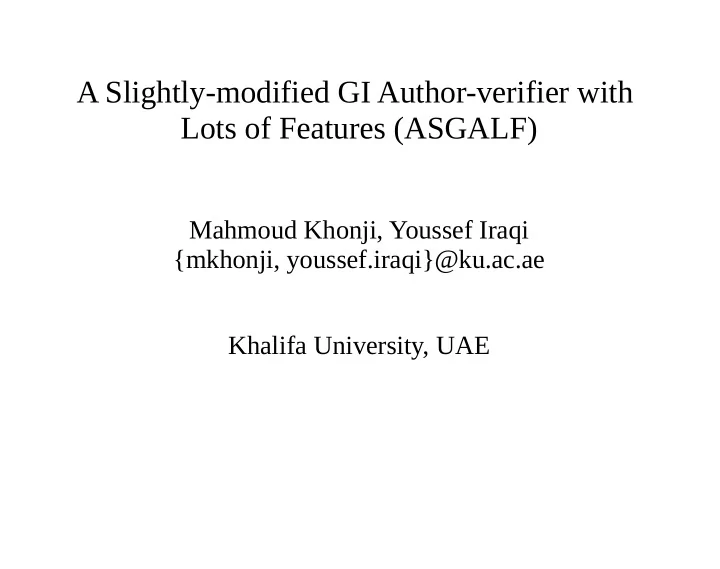

A Slightly-modified GI Author-verifier with Lots of Features (ASGALF) Mahmoud Khonji, Youssef Iraqi {mkhonji, youssef.iraqi}@ku.ac.ae Khalifa University, UAE
Outline • General Impostors (quick intro; our imp.) • Score aggregation. • Features. • Parameter tuning. • Stuff that are possibly limitations of our classifier.
GI (quick intro reflecting our imp.) score = 0 general_impostors ( knowns , unknown ): n = | knowns | forall known in knowns : score += impostors ( known , unknown ) / n if score > threshold: return “same” else return “notsame”
impostors ( known, unknown ): score2 = 0 for 1 ... runs_num : imps = get_imps_rnd ( lang-genre-docs, n ) fs = get_fs_rnd ( features, f ) best_imp_to_known best_imp_to_unknown forall imp in imps : sim_k = sim ( imp, known ) sim_u = sim ( imp, uknown ) best_imp_to_known = imp if higher sim best_imp_to_unknown = imp if higher sim
if sim ( known, unknown )^2 > sim ( sim_k, known ) * sim ( sim_u, unknown ): score2 += 1/ runs_num return score2
Score aggregation Instead of: if x > y : score2 += 1/ runs_num We did: score2 += x/y
Features All n-grams that have occurred at least 5 times in any document. n ∈ {1, ..., 10} gram ∈{ letters, words, words_function, words_shape, words_post, words_post-word}
Features examples words_functions: If x, y, and z are function words in “x .... y .... z ...”, then a 2-gram would be {x:y, y:z}. words_post: “saw the saw” would become “VBD DT NN”, then a 2-gram set would be {VBD:DT, DT:NN} words_post-word: “saw the saw” would become “saw-VBD the-DT saw-NN”, then a 2-gram set would be {saw- VBD:the-DT, the-DT:saw-NN}
Parameter tuning Assuming threshold = 0.5, apply a correction to the score to maximize accuracy. First, find optimal threshold ( exhaustively). One that maximizes accuracy on training set. Then, correction = 0.5 - threshold.
Stuff that are possibly limitations • Not fully taking advantage of C@1. • Parameters are not found rigorously (a few manual trials). • Using min-max might not show some interesting patterns. • Being too-spoiled by impostors robustness against noisy features (using too many features slowed our implementation while possibly not adding much value) • The usual things: clumsy code.
Acknowledgement Thanks to Shachar Seidman for answering our questions about GI.
Thank you
Recommend
More recommend